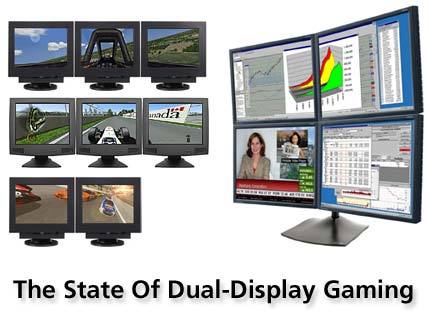Dual Display Gaming Bigs Up
Introduction
Almost all graphics cards sold today offer multi-display features, meaning they offer connectivity to more than one monitor. While NVIDIA and ATi cards usually sport a maximum of two VGA connectors, cards such as Matrox' Parhelia can accommodate as many as three.
It's a fact that multi-display workstations make life a lot easier when dealing with everyday applications such as office programs, graphics, etc. Also, prices of 19" CRTs and even 17" TFT monitors have recently dropped enough to make multi-monitor environments affordable and interesting, especially considering that most graphics cards come with multi-monitor capabilities. Games, however, have been late to take advantage of multi-displays. There is only a small number of games that support multi-display modes. Instead, many game developers try to cram as much of their game's interface onto one screen as possible. In some cases, you can't see the game for all the menus.
Although we don't have any statistics on the number of gamers who use a multi-monitor setup, we're sure that many games would benefit from such a setup. Take Battlefield 1942 as an example. In a dual-view setup, the primary display could show the ongoing game, while the secondary display shows a large version of the in-game map and houses the chat windows. This would get rid of the annoying and distracting clicking back and forth between windows.
In racing games, the second display could show an overhead view of the field, giving the player an overview of his position in the pack. The relevant information in real-time-strategy titles or economic simulation games would no longer have to be accessed painfully through menus and sub-menus or hotkey combinations, but could be available on the second screen.
This is a mock up - but wouldn't it be nice to play Desert Combat that way? Full-scale map, scoreboard and chat window on the second screen?
Unfortunately, reality does not reflect a promising a picture. While many games support extending the viewable area beyond the boundaries of the first monitor (Surround Gaming), most would really require three monitors to live up to a truly immersion gaming experience. Most of the time, when only two monitors are used, the bezels of the two monitors are in the center of the scene, and obviously distract and detract from the experience. That leaves only a handful of titles that offer usable two-monitor configurations, the most popular being Egosoft's "X2 - The Threat" and Microsoft's "Flight Simulator 9 - A Century of Flight." Before we get to the games themselves, though, we would like to offer an introduction on the multi-display functionality of graphics cards.
Get Tom's Hardware's best news and in-depth reviews, straight to your inbox.

